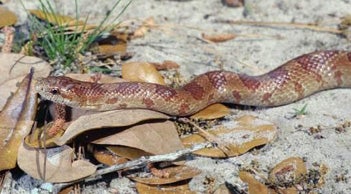SCIENTIFIC NAME:
Lampropeltis calligaster calligaster (Harlan)
OTHER NAMES:
Yellow-bellied Kingsnake.
STATUS:
Peripheral and uncommon in Interior Plateau, and possibly Appalachian Plateau north of Tennessee River. Known from Madison County, and may occur in Limestone and Jackson Counties. MODERATE CONSERVATION CONCERN.
DESCRIPTION:
Can attain a length more than 140 centimeters (approx. 4.5 feet), although specimens seldom exceed one meter (three feet). Head scarcely larger than neck and somewhat depressed. General ground color varies from tan to brownish gray. A row of approximately 60 brown or rusty black-edged blotches runs down the back, alternating with rows of smaller blotches on the sides, which sometimes fuse together (Johnson 1987). In some older specimens, the ground color darkens, and the pattern becomes obscure or even resembles faint longitudinal stripes. Belly creamy to yellow, with squarish brown blotches (Anderson 1965). The other subspecies, the mole kingsnake, more widely distributed in Alabama, typically has a more brownish to rusty ground color, and the dorsal blotches are somewhat greater in number (Mount 1975).
DISTRIBUTION:
Central Midwestern states west through Kansas, Oklahoma, and eastern Texas and east to northern Mississippi and central Tennessee (Smith 1961). The mole kingsnake is found to the south and east of this distribution, and is the predominant subspecies in Alabama (Mount 1975). The prairie kingsnake has a peripheral distribution in Alabama, with a handful of specimens confirmed only from Madison County in the extreme northern portion of the state (Mount 1975), although it likely occurs in scattered locations in the surrounding counties north of the Tennessee River.
HABITAT:
A resident of open or semi-open habitats, as opposed to the mole kingsnake’s preference for more forested areas. In the Midwest, prefers old fields and grassland prairies, but also inhabits open woodlands and patches of savanna or rocky terrain in the midst of forested country (Anderson 1965, Fitch 1979). Often found close to human habitation and farm buildings (Johnson 1987).
LIFE HISTORY AND ECOLOGY:
A fairly secretive snake that frequently utilizes mammal burrows. For much of year, hunts in daylight hours, but during peak of summer becomes more active nocturnally (Johnson 1987). Mice and other small mammals constitute two-thirds of the diet, but lizards, small snakes, amphibians, small birds, and an occasional insect also taken (Klimstra 1959, Snyder 1972). Large food items constricted, but smaller ones simply swallowed. Mates in early spring after emerging from winter dormancy. Six to 18 adherent eggs laid in moist soil under cover in early summer hatch in August or September. Hatchlings strongly spotted and average approximately 25 centimeters (10 inches) long (Shoop 1957).
BASIS FOR STATUS CLASSIFICATION:
Very limited distribution and low population density in Alabama. Rapid urbanization occurring in Madison County is cause for increasing concern. Additionally, egg-laying snakes face increasing population levels of red imported fire ants in northern Alabama, along with localized areas of high pesticide use on agricultural crops.
Author:
R. Marion






